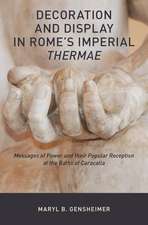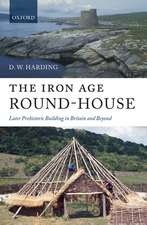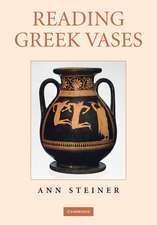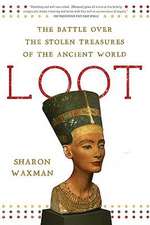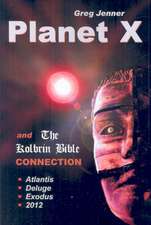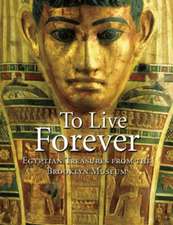The Tiny and the Fragmented: Miniature, Broken, or Otherwise Incomplete Objects in the Ancient World
Editat de S. Rebecca Martin, Stephanie M. Langin-Hooperen Limba Engleză Hardback – 3 ian 2019
Preț: 509.93 lei
Preț vechi: 680.04 lei
-25% Nou
Puncte Express: 765
Preț estimativ în valută:
97.58€ • 100.66$ • 81.43£
97.58€ • 100.66$ • 81.43£
Carte tipărită la comandă
Livrare economică 15-21 martie
Preluare comenzi: 021 569.72.76
Specificații
ISBN-13: 9780190614812
ISBN-10: 0190614811
Pagini: 248
Dimensiuni: 236 x 157 x 18 mm
Greutate: 0.48 kg
Editura: Oxford University Press
Colecția OUP USA
Locul publicării:New York, United States
ISBN-10: 0190614811
Pagini: 248
Dimensiuni: 236 x 157 x 18 mm
Greutate: 0.48 kg
Editura: Oxford University Press
Colecția OUP USA
Locul publicării:New York, United States
Recenzii
This edited volume is a welcome and thought-provoking contribution to the literature on two important phenomena: miniaturization and fragmentation. ... This book will therefore be indispensable for anyone working on either of these themes in the future. And indeed, The Tiny and the Fragmented convincingly argues that most of us are in one way or another working on these themes (especially fragmentation), whether we realize it or not. ...The Tiny and the Fragmented is an important and timely contribution... In its interdisciplinary scope and willingness to ask new questions, the volume looks ahead to the future of multiple fields. And in its championing of forms of material culture whose historical, cultural, and theoretical importance is too often overlooked, this book reveals the power of "the tiny and the fragmented" to shape human experience.
The Tiny and the Fragmented is an important and timely contribution. Miniaturization and fragmentation are topics of broad significance within archaeology and art history, and this volume should spur new debate on both. In its interdisciplinary scope and willingness to ask new questions, the volume looks ahead to the future of multiple fields. And in its championing of forms of material culture whose historical, cultural, and theoretical importance is too often overlooked, this book reveals the power of "the tiny and the fragmented" to shape human experience.
...the strength of the individual chapters is such that each will surely make an important contribution to its specific field, and perhaps in turn will bring readers to look into the sort of anthropological questions and approaches to miniaturization and fragmentation that the editors so eloquently advocate.
A chief virtue of the book...is its range of perspectives...The volume certainly brings together a range of specialists - discussing, among other things, Assyrian friezes (Marian H. Feldman), Iberian Iron-Age figurines (Mireia López-Bertran and Jaime Vives-Ferrándiz) and Neolithic pit-houses
A compelling interdisciplinary re-evaluation of the tiny and the broken in the archaeological record. The papers in this volume challenge the basic dichotomies of miniature and monumental, fragment and whole, to push beyond understanding miniatures through reconstruction and type. Instead these studies, ranging from Honduran figurines to Classical anatomical votives, use new theoretical approaches to reconsider what constitutes completeness and to re-imagine what these objects do and how people interact with them. A must-read contribution that elucidates the power and allure of the small and fragmentary.
The Tiny and the Fragmented offers insightful perspectives on the nature of small, or partially-preserved, archaeological finds that challenge prevailing notions about the perceived importance of 'completeness' as it pertains to the archaeological record. Reflective of new theoretical approaches, the nine papers in this volume each provide a different roadmap to follow for a deeper understanding of purposeful user entanglement with material culture in the ancient world. As a result of reading these papers we learn that fragmentation and miniaturization may have been one of the means by which culturally coded messages were transmitted across complex socio-religious networks.
The Tiny and the Fragmented presents the best of new directions in interdisciplinarity in ancient studies - bringing anthropology and art history, classics and archaeology in conversation around important theoretical questions of scale, miniaturization and the unfinished, and considering how these questions can contribute to a better understanding of the archaeological record.
The Tiny and the Fragmented is an important and timely contribution. Miniaturization and fragmentation are topics of broad significance within archaeology and art history, and this volume should spur new debate on both. In its interdisciplinary scope and willingness to ask new questions, the volume looks ahead to the future of multiple fields. And in its championing of forms of material culture whose historical, cultural, and theoretical importance is too often overlooked, this book reveals the power of "the tiny and the fragmented" to shape human experience.
...the strength of the individual chapters is such that each will surely make an important contribution to its specific field, and perhaps in turn will bring readers to look into the sort of anthropological questions and approaches to miniaturization and fragmentation that the editors so eloquently advocate.
A chief virtue of the book...is its range of perspectives...The volume certainly brings together a range of specialists - discussing, among other things, Assyrian friezes (Marian H. Feldman), Iberian Iron-Age figurines (Mireia López-Bertran and Jaime Vives-Ferrándiz) and Neolithic pit-houses
A compelling interdisciplinary re-evaluation of the tiny and the broken in the archaeological record. The papers in this volume challenge the basic dichotomies of miniature and monumental, fragment and whole, to push beyond understanding miniatures through reconstruction and type. Instead these studies, ranging from Honduran figurines to Classical anatomical votives, use new theoretical approaches to reconsider what constitutes completeness and to re-imagine what these objects do and how people interact with them. A must-read contribution that elucidates the power and allure of the small and fragmentary.
The Tiny and the Fragmented offers insightful perspectives on the nature of small, or partially-preserved, archaeological finds that challenge prevailing notions about the perceived importance of 'completeness' as it pertains to the archaeological record. Reflective of new theoretical approaches, the nine papers in this volume each provide a different roadmap to follow for a deeper understanding of purposeful user entanglement with material culture in the ancient world. As a result of reading these papers we learn that fragmentation and miniaturization may have been one of the means by which culturally coded messages were transmitted across complex socio-religious networks.
The Tiny and the Fragmented presents the best of new directions in interdisciplinarity in ancient studies - bringing anthropology and art history, classics and archaeology in conversation around important theoretical questions of scale, miniaturization and the unfinished, and considering how these questions can contribute to a better understanding of the archaeological record.
Notă biografică
S. Rebecca Martin is Associate Professor of Greek Art and Architecture in the Department of History & Architecture and Associate Professor in the Archaeology Program at Boston University. She is the author of The Art of Contact Comparative Approaches to Greek and Phoenician Art (2017).Stephanie M. Langin-Hooper is Assistant Professor and Karl Kilinski II Endowed Chair in Hellenic Visual Culture Department of Art History at Southern Methodist University. Her research focuses on issues of miniaturization, identity, and cross-cultural interaction in the terracotta figurines of Hellenistic Babylonia.

